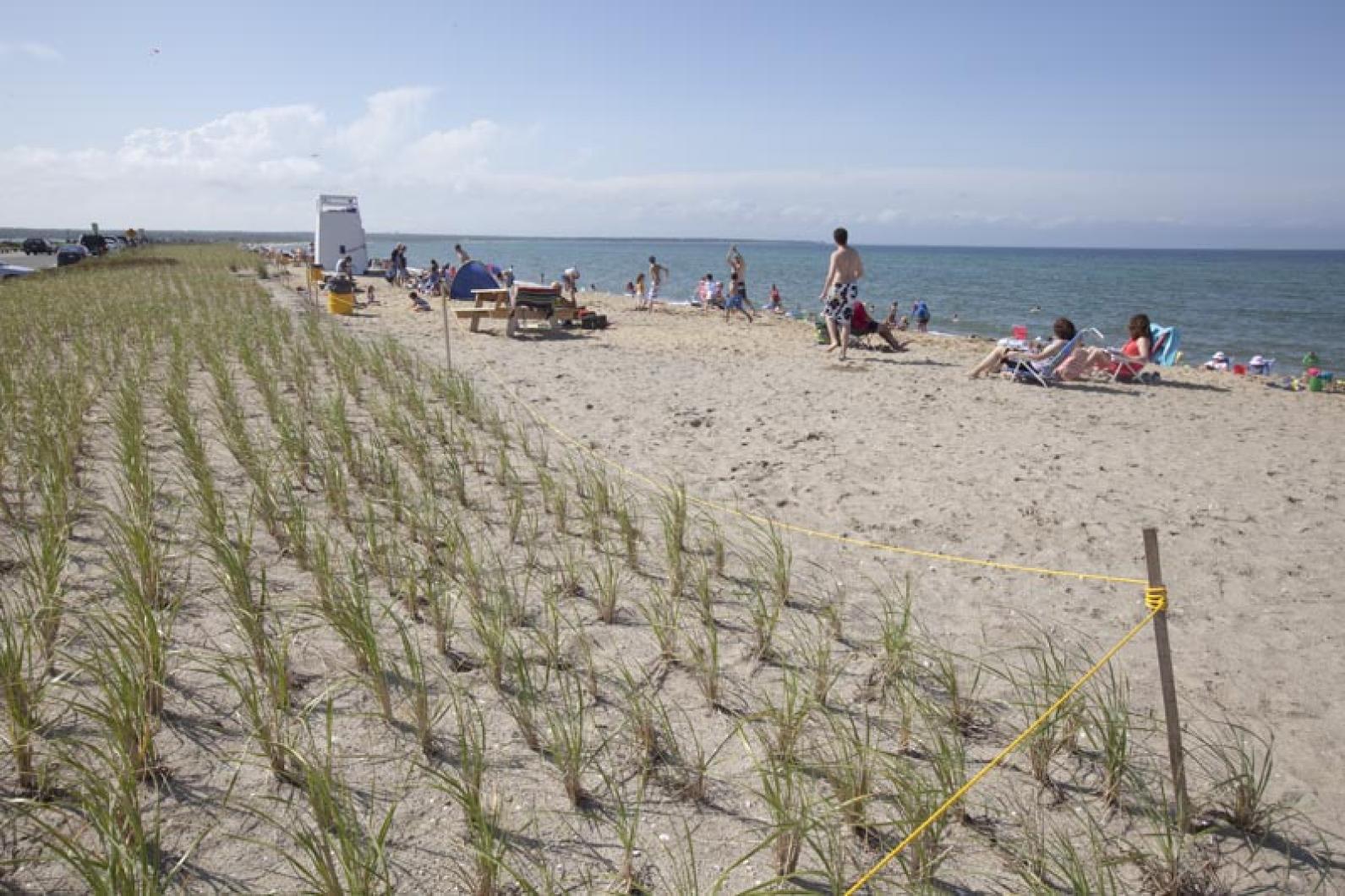Bumps were smoothed out in a sand renourishment project at Bend in the Road Beach in time for summer. Unfortunately this meant that part of it slid in to the ocean.
Complaints from a set of retired town leaders at a selectmen’s meeting in May argued that dune restoration had diminished the size of the beach and obscured the views from Beach Road, led to a site inspection with various town departments.
Though some project participants argued that the beach remained a work in progress, selectmen ruled that it should be regraded to smooth out the slope to the shoreline.
“That is one section of the beach that is public and there to be enjoyed and to be honest I don’t really care about dune restoration in that one piece,” said selectman Michael Donaroma yesterday, “[Conservation agent] Jane Varkonda was the only one there standing there defending the dune. In the end we compromised.”
The regrading work on the beach was carried out by the town dredge department, creating a gradual slope to the water’s edge.
Then a strong northeast storm in early June washed away a portion of the spoils. Dredge committee member Charles Blair for one was not surprised.
“Mother Nature profiles the beach the way she wants,” he said. “I’ve done this many times.”
The Bend in the Road restoration project is a private-public partnership between the town of Edgartown and the Cow Bay beach homeowners association.
The association contributed funds — $150,000 of approximately $250,000 of the project to date — in return for sand, specifically 17,000 cubic yards of spoils from the dredging of Sengekontacket Pond for its beach. The sand was obtained using the town dredge.
The project has suffered multiple setbacks. First, there was not enough sand. Originally the town had planned to dredge the sand from the opening to Trapp’s Pond but when operators found large amounts of peat and fine sand, unsuitable for the beach, the committee decided to dredge for just 40,000 cubic yards from another area near the Big Bridge, where dredging permits were still valid from a 1997 project.
The plan was to transfer 30,000 cubic yards to Cow Bay and 10,000 cubic yards to the Bend in the Road. In the end, Cow Bay got 17,000 cubic yards and the Bend in Road received 6,000.
Then the Cow Bay association, mired in permitting delays, did not begin until December and was forced to stop in mid-February due to state dredging restrictions.
Both town and private projects have been split into two phases.
The first focused on dune restoration; dunes built into the town side which abuts Beach Road have raised the beach from roughly two feet below street level to an elevation of five feet.
In phase two the committee will seek to widen the beach by adding sand either from Eel Pond or another part of Sengekontacket Pond.
Mr. Blair, who is also the Edgartown harbor master and has acted as de-facto foreman for the dredge program for some seven years, said the Bend in the Road project has suffered from improper management.
“The town let the project slip out of their hands,” he said.
For her part Jane Varkonda, who has been involved in the project in several guises — as conservation agent, park commissioner, and recently dredge committee member — did not want to play the blame game.
“It’s easy to point the finger but we don’t know. It is what it is. You live and learn, doing a project,” she said, adding:
“There was some knee-jerk reaction to the results. We wanted to see if Mother Nature dealt with it. But it wasn’t finished; we should have kept a curtain over it.”
Dredge committee chairman Norman Rankow said he hopes phase two of the project will begin this fall, but much depends on permitting and the weather. “It’s a complicated process,” Mr. Rankow said.
The permitting gauntlet will involve the Army Corps of Engineers, Natural Heritage, the Department of Environmental Protection and other state agencies, as well as the town conservation commission.
The town will seek to work in tandem with abutters to Cow Bay beach and State Beach in order to bolster the added sand to prevent it washing away.
“If we all work together it will last longer,” said Mr. Rankow.
Meanwhile, major operational changes within the town dredge department reveal an organization in flux.
Lynne Fraker, who served for 10 years as administrator of the dredge program, lost her job on July 1 when her two-year contract was not renewed.
“She is no longer working for us at this time,” Mr. Rankow said.
The department has hired a full-time foreman and is advertising for a bookkeeper’s position.
“We just felt we needed a change in the way we do the project, we were not happy in the way the program was running and felt we needed to look in the mirror, and figure out how we could get better management. We reformulated the whole program looking for ways to save money as budget’s get tighter,” Mr. Rankow said.
He acknowledged that creating two new positions in place of one will mean more cost, but he said leftover money in a dredge gift account will help close the funding gap.
And Mr. Rankow praised the choice of Ed Handy for foreman, a position that has not been formally held since the inception of the dredge program 14 years ago. He argued the hire will ultimately mean savings.
“Ed has a tremendous wealth of knowledge and we can put some more load on his shoulders. He’ll be handling the nuts and bolts end of the program. It’s hard to run a program by committee. We’ve been doing it for 14 years and thought, how can we make it better?” He concluded:
“A good guy can help earn his keep. You get better bang for the buck.”




Comments (2)
Comments
Comment policy »